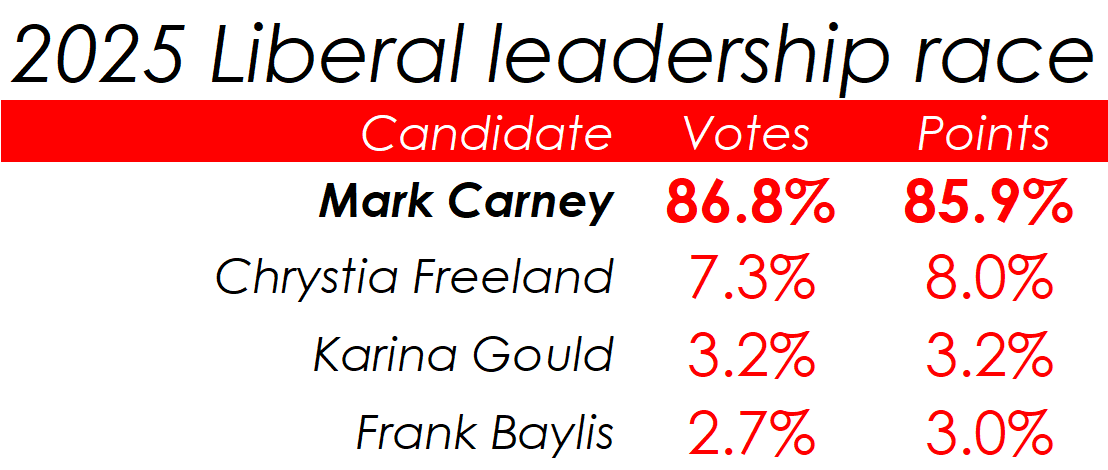Weekly Writ 3/12: After dominant leadership win, where will Carney run?
His options run the gamut of the good, the bad and the ugly.
Welcome to the Weekly Writ, a round-up of the latest federal and provincial polls, election news and political history that lands in your inbox every Wednesday morning.
Mark Carney’s win on Sunday was big.
When Pierre Poilievre won the Conservative leadership race in 2022, I wrote here on The Writ that “Poilievre wins big — everywhere”. I guess it would be fair to now say that Carney won even bigger — and in even more places.
The former Bank of Canada governor took 85.9% of the points on offer and 86.8% of ballots cast. Poilievre won 68.2% and 70.7%, respectively. While Poilievre prevailed in 330 of 338 ridings, Carney went 343 for 343, with none of them being particularly close.
Alex Kohut, who formerly did polling for the Liberals in the PMO, broke down the results in great detail on his Substack and I’m not going to attempt to improve upon that. In short, Carney won everywhere by huge margins, even in the ridings represented by Chrystia Freeland and Karina Gould. While Gould under-performed expectations by taking just 3.2% of the points, Freeland’s 8% was rather humiliating for a former deputy prime minister, finance minister and one-time hier apparent to Justin Trudeau.
About 152,000 registered Liberals managed to cast a ballot, with Carney taking 132,000 of those votes. Freeland, his nearest competitor, got 11,000. That was even lower than the 12,000 votes won by Joyce Murray in Trudeau’s landslide leadership victory in 2013.
There has been some reporting on the turnout in the contest with questions raised about why it was so low when compared to the nearly 400,000 people who registered with the party. I’m a little perplexed by the apparent concern. There were 294,000 registered Liberals in the 2013 contest but only 105,000 voted. Turnout among the total registered membership was only around 36% in 2013. It doesn’t seem like a baffling mystery to me, or any particular cause for alarm, that turnout in 2025 was around 38%.
We can dismiss out of hand the ridiculous claim that those who didn’t vote were Ruby Dhalla’s supporters — her poor fundraising alone suggests she would have done no better than Baylis or Gould had she not been disqualified from the running (and likely would have done even worse). Instead, there are two simple answers for why the turnout was low:
Signing up for free to be a registered Liberal is not the same as being a paid-up member of a party. Comparing turnout in the Conservative leadership race to turnout in the Liberal leadership is an apples-to-oranges comparison. There’s a different level of commitment between paying for a membership and just filling out a form.
The process for verification was reportedly difficult for some registered Liberals, which undoubtedly had an impact on the total number who cast a ballot. But the similar turnout rate in 2025 to 2013 suggests it might not have been all that impactful — or at least not much more of a problem than it was last time.
The results should probably make the Liberals think again about their free membership policy if its low bar for entry then necessitates an onerous verification process to prevent foreign (and domestic) interference. But I don’t think the low turnout among the total registered membership was surprising.
What surprises are still in store, however, surround the next election. There’s the uncertainty about the outcome itself, which my The Numbers co-host, Philippe J. Fournier, and I discussed on The National on Monday night:
There’s also the question of when the election will be called — and where Mark Carney might run for a seat.
Before running through his seat options, a little housekeeping. If the election is called within the next week, that means The Writ will transition to election mode. During the campaign, you can expect daily newsletters and more frequent episodes of The Numbers, The Writ Podcast and Les chiffres, along with some more content on The Writ’s YouTube Channel. I’ll also be updating the CBC’s Poll Tracker every day and including analysis of those numbers in the daily newsletters (most of which will be for subscribers only). The seat-by-seat projections for the Poll Tracker will also be updated daily and available to subscribers here.
I’m finalizing my planning for the daily newsletters, but I’d like to hear your thoughts. The newsletter will include analysis of the latest polls, some regional spotlights and a dash of history (an abridged On This Day in the #EveryElectionProject). But is there anything else you’d like to see in the daily newsletters? Let me know!
Now, to what is in this week’s instalment of the Weekly Writ:
Analysis of Carney’s options for a riding, plus news on leadership races in Newfoundland and Labrador, Prince Edward Island and Manitoba, along with a byelection that will probably never happen, caucus ejections and MP retirements.
The last pre-Carney federal polls and some new provincial polling numbers out of British Columbia and Quebec.
A slim majority for the Parti Québécois if the election were held today.
The 1971 Alberta Liberal leadership race in the #EveryElectionProject.
Upcoming milestone for Scott Moe.
IN THE NEWS
Where could Mark Carney run for a seat?
Out of the all the questions that have yet to be answered — when Carney will be sworn in, who will be in his cabinet and when will he drop the writ — the question of where he will run might be of secondary importance. Except to nerds like us.
So, where could Carney run? And what are some of the best options available to him? Let’s take a look at his best options.



